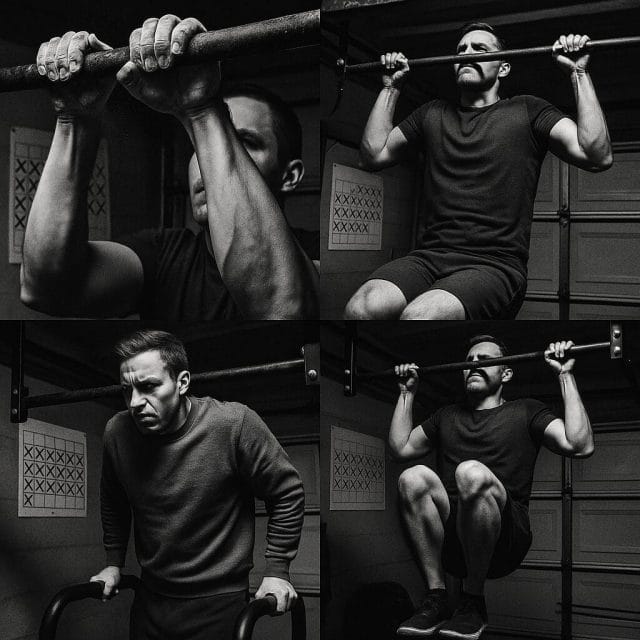Good morning indeed — and what a morning to celebrate. After a full year of daily commitment, the challenge to complete chin-ups, dips and knee raises has come to a satisfying close. It’s the sort of announcement that sounds simple in a sentence but contains hundreds of hours of effort, thousands of reps and a wealth of learning hidden between each controlled repetition. If you’ve ever wondered what daily training looks like when it’s stripped back to essentials — no frills, no machines, just a bar, parallel bars and resolve — this is it.
What the Challenge Entailed: A Daily, Rising-and-Falling Rep Ladder
The structure was as elegant as it was demanding: do the work every day, build the reps up to a peak of 70, and then gradually taper back down to 10. That sounds straightforward, but it’s a masterclass in consistency and smart volume control. This rising-and-falling ladder (sometimes called wave loading or a pyramid) has several strengths:
- It manages fatigue by letting you climb progressively rather than leaping to high volume too soon.
- It provides a psychological arc — a clear destination (70 reps) and a release valve (the journey back down).
- It encourages technical consolidation; the closer you get to the peak, the more your form needs to be disciplined, and the descent allows you to refocus on crisp execution.
Daily training of bodyweight moves demands careful pacing. Most people who succeed at it don’t hammer out all reps in one go. They break the volume into micro-sets sprinkled through the day — a few reps every hour, or ladders like 2-3-5 repeated for multiple rounds — to accumulate fatigue-resistant quality. The key is keeping each small effort submaximal, so technique doesn’t fray and tendons aren’t pushed beyond what they can recover from in 24 hours.

Why These Three Moves? Push, Pull, Core — The Minimalist Trio
Chin-ups and pull-ups, dips, and knee raises form a balanced calisthenics triangle: a vertical pull, a vertical push, and a dynamic core movement. Together they train a lot more than meets the eye:
- Chin-ups/pull-ups emphasise the lats, upper back and biceps, but done well they also teach you scapular control (depression and retraction), grip resilience and trunk tension.
- Dips train the chest, anterior deltoids and triceps while reinforcing shoulder stability through controlled depth and scapular depression.
- Knee raises target the anterior core and hip flexors; when performed with a posterior pelvic tilt (tucking the tailbone under at the top), they light up the lower abs and build anti-swing control that carries over to all hanging work.
In combination, they create a simple but potent programme. You can do them almost anywhere, they scale well with tempo and leverage, and they reward attention to detail. For a daily routine, this trio sits at the sweet spot of difficulty and recoverability.
Chin-Ups vs Pull-Ups: A Tactical Swap When Soreness Strikes
Along the way, there was a practical change: occasionally swapping some chin-ups for pull-ups when the ankle started getting sore. On the face of it, the ankle seems far removed from the bars, but daily hanging and leg work can produce unexpected grumbles — especially during knee raises, where foot position, subtle contact against pads or restless stabilising can irritate things further down the chain. The broader lesson is gold: variation protects longevity.
Here’s how chin-ups and pull-ups play off each other:
- Chin-ups (supinated or underhand grip) typically engage more biceps and allow a slightly stronger line for many lifters. They can feel friendlier on the shoulders and are useful for building volume.
- Pull-ups (pronated or overhand grip) shift emphasis to the upper back and brachialis and challenge grip and scapular control differently. They often reduce elbow supination demands, which can provide relief upstream or downstream when something is niggly.
Using both throughout a long challenge spreads the load across tissues, changes the exact movement pattern and keeps training psychologically fresh. If an ankle or any joint complains, pause, adjust, and redirect the stress — a tweak to grip, tempo or ROM can be the difference between persisting and sidelining yourself.

Climbing to 70 Reps: Strategies That Make High Volume Sustainable
Seventy daily reps of a demanding movement is no casual walk to the bar. To get there without wreckage, two strategies are invaluable:
- Ladders and density blocks: Set a timer for 20–30 minutes and run ladders like 1-2-3-4 repeated, resting the minimum needed to keep reps crisp. Alternatively, EMOM (every minute on the minute) sets of 3–5 reps build rhythm and prevent burnout.
- Grease-the-groove (GTG): Scatter micro-sets across your day. For example, five to seven singles or doubles each time you pass the bar. Continuity beats intensity here — you’re teaching your nervous system economy, not chasing depletion.
For dips and knee raises, the same logic applies. You might do 5 sets of 10 dips spread over the morning and another 2–3 sets later in the day. For knee raises, aim for impeccable control: start each rep from a dead hang, initiate with the abs (not with a swing), tuck the pelvis at the top, and pause before lowering under control. Accumulating sets with quality will get you to 70 not just safely, but stronger than when you began.
Form First: Technique Cues That Compound Over a Year
Over a year, small technical lapses become big liabilities. Build these cues into your reps and the movements will pay you back with strength and resilient joints.
Chin-Ups/Pull-Ups
- Start with a passive-to-active hang: depress and slightly retract the scapulae before the first pull. Keep ribs down; avoid flaring through the lower back.
- Think “drive elbows to hips”. Keep the neck neutral; finish with chest tall to the bar rather than craning the chin.
- Control the eccentric. A 2–3 second lower builds tendon strength and grip endurance without extra load.
Dips
- Shoulders down and away from ears. Maintain a slight forward lean, ribs down, and forearms vertical at the bottom.
- Depth is individual. Aim for upper arms roughly parallel to the ground while keeping shoulders feeling solid; don’t chase extreme range at the expense of stability.
- Press through full lockout without hyperextending elbows; squeeze the bars to light up the triceps.
Knee Raises
- Begin every rep with a dead stop — eliminate swing. Exhale as you raise, and posteriorly tilt the pelvis (tuck) to engage the lower abs.
- Stop just short of the point where you’d compensate with a swing. Quality beats height.
- Lower slower than you lift. The eccentric is where a lot of core strength is earned.
These principles don’t just make you stronger; they distribute stress sensibly, which is crucial in a daily routine.
Daily Training Realities: Recovery, Soreness and the Art of Carrying On
Doing something every day changes your training psychology. You stop chasing the “perfect session” and start prioritising consistency. It also tunes your antennae for fatigue. Soreness is inevitable, but it should be the manageable, background variety — not sharp, pinpoint pain. When something feels off, you have levers to pull: reduce the volume that day, switch grip, adjust tempo, or swap to an accessory movement like scapular pull-ups or support holds.
Recovery becomes minimalistic but intentional:

- Sleep is the number one supplement. Most connective tissue adapts slowly; without sleep, daily training turns into daily erosion.
- Nutrition supports tissue repair. Aim for protein at each meal (roughly 1.6–2.2 g per kg of bodyweight per day) and sufficient carbohydrates to fuel high-frequency work.
- Prehab matters. A few minutes of shoulder controlled articular rotations (CARs), forearm/wrist extensor work, and gentle calf/ankle mobility can pay back tenfold — especially with the odd ankle niggle cropping up.
On the descent from 70 reps back to 10, recovery blossoms. You’ll notice technique sharpening and joints sighing with relief. This is by design: the taper consolidates gains and sets you up to finish strong rather than limp over the line.
Tracking and Motivation: Turning Daily Reps into Momentum
Nothing fancy is required, but a simple training log is transformative. Jot down the date, the rep breakdown, and a quick note on how it felt (use a 1–10 RPE if you like). Over months, you’ll see patterns — perhaps pronated grips feel better after a rest day, or your knee raises improve when you cluster them in the afternoon. These insights make adjustments obvious and keep motivation high.
Habit-wise, stacking is your friend. A “good morning” ritual — one short set upon waking — anchors the day. Another small cluster after lunch, another before dinner. Instead of seeking motivation, you rely on a system that removes friction. The year passes one micro-set at a time.

“Alright, I’m Going to Do 10”: Finishing with Intent
There’s a special satisfaction in saying, “Alright, let’s keep going. I’m going to do 10,” and then simply doing it. It’s not bravado; it’s the plain confidence that comes from thousands of clean reps and a body that knows the groove. The final sets in a long challenge are often the sweetest: light enough to move flawlessly, significant enough to feel the weight of the journey.
That last set of 10 is more than reps. It’s a victory lap for discipline, patience and adaptability — the quiet kind of triumph that doesn’t need an audience.
Lessons Learned from a Year on the Bars
- Consistency beats intensity. The magic isn’t in any single set; it’s in showing up daily and doing what you said you’d do.
- Variation is a recovery tool. Swapping chin-ups and pull-ups, adjusting grip width, or slightly changing tempo spreads load and preserves joints.
- Form compounds. Tiny technical improvements accrue interest over a year, showing up as stronger joints, cleaner reps and fewer setbacks.
- Programme the taper. Peaks are only useful if you come down intelligently. The descent fortifies gains and keeps your body eager rather than exhausted.
How to Start Your Own Minimalist Challenge
If this year-long project is calling to you, begin with a sustainable foundation. Here’s a simple eight-week on-ramp before you consider a longer horizon:
Weeks 1–2: Establish the Groove
- Daily: 10–20 total chin-ups/pull-ups, 20–30 dips, 20–30 knee raises.
- Break into micro-sets of 2–5 reps. Keep 2 reps “in the tank” every set.
- Practice scapular pull-ups and hollow-body hangs as accessories.
Weeks 3–4: Build Density
- Increase to 20–30 total chin-ups/pull-ups, 30–40 dips, 30–40 knee raises.
- Use EMOMs: 5 reps on the minute for 6 minutes (adjust to stay crisp).
- Emphasise controlled eccentrics (2–3 seconds down).
Weeks 5–6: Introduce Variation
- Alternate days: chin-ups one day, pull-ups the next.
- Work towards 30–50 total reps per movement across the day.
- Add paused reps (1–2 seconds at the top) for knee raises.
Weeks 7–8: Peak and Taper
- Climb to a personal peak (e.g., 50 total pull/chin reps, 60 dips, 60 knee raises) over the first week.
- Reduce volume by 30–40% in week eight while keeping technique immaculate.
From there, you can set your long-term ladder — perhaps aiming for that classic 70-rep peak — with the assurance that your base is solid. Remember: never let today’s ambition steal tomorrow’s capacity. Adjust on the fly and keep reps beautiful.
Common Pitfalls to Avoid
- Chasing numbers over quality. Ten clean reps beat fifteen sloppy ones, especially over a year.
- Neglecting grip and shoulder prep. Add forearm extensor work and daily shoulder CARs to your warm-up.
- Letting swing creep into knee raises. Reset to a dead hang between reps if needed.
- Ignoring niggles. Swap grips, cut volume or rest a day if pain is sharp. Your long game matters most.
What’s Next After the Finish Line?
Completion doesn’t have to mean stopping. You might maintain with a lower daily volume, or pivot to related goals: strict toes-to-bar, weighted dips, or a milestone like your first muscle-up. The base you’ve built — stronger grip, resilient shoulders, disciplined core — will carry across to any upper-body or calisthenics goal you choose.
Most importantly, keep the spirit of the routine alive. The minimalist programme works not because it’s flashy, but because it fits into real life. A bar, a set of parallel bars, and the resolve to keep showing up — that’s enough to change your body and your mindset, one rep at a time.

If this article helped you in any way and you want to show your appreciation, I am more than happy to receive donations through PayPal. This will help me maintain and improve this website so I can help more people out there. Thank you for your help.





